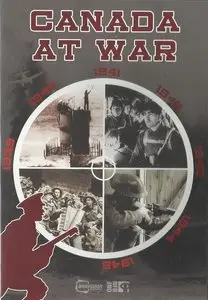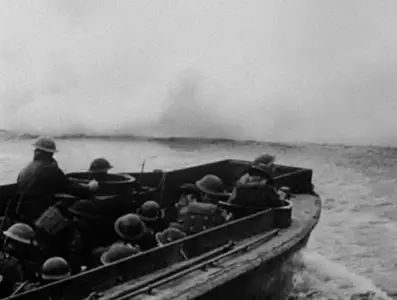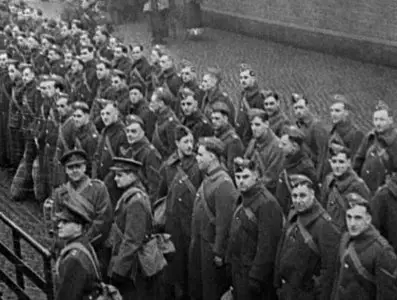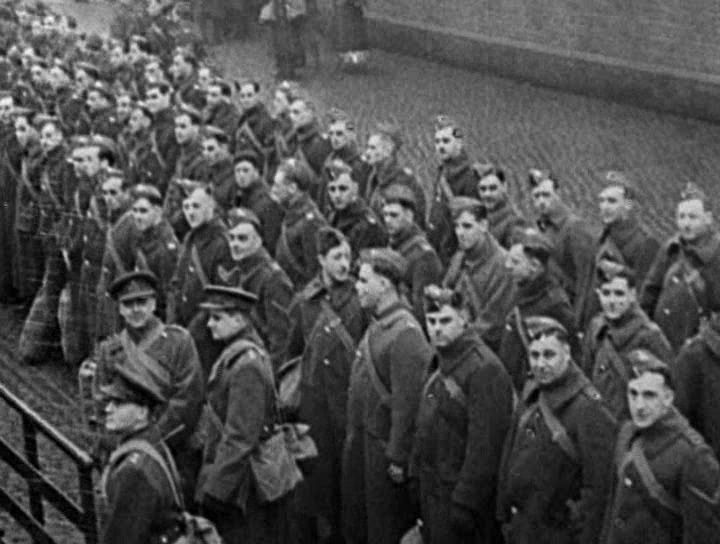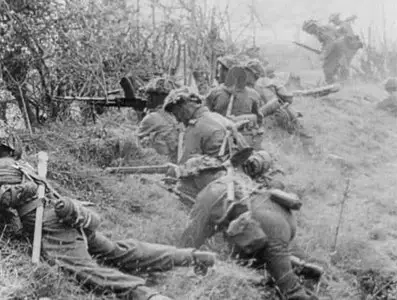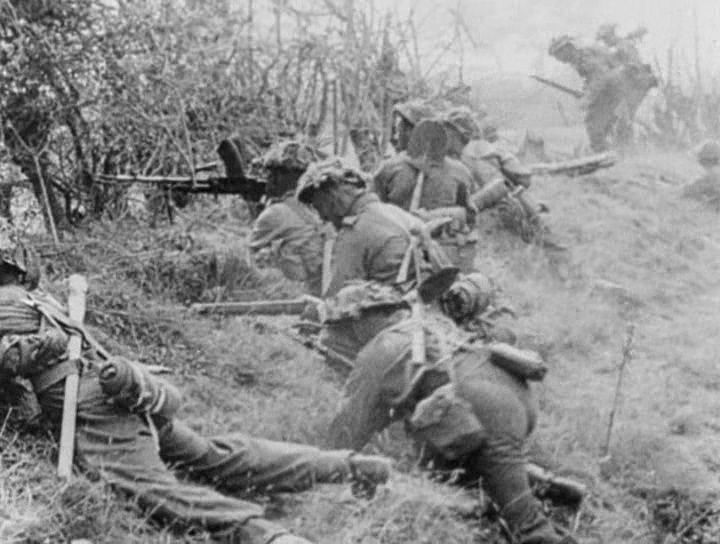NFB - Canada at War (1962)
DVDRip | English | AVI/DivX 23.976 fps 2240 Kbps | 720x544 | AC3 256 Kbps 48.0 khz | 13x27mn | 13x498 MB
Genre: Documentary
DVDRip | English | AVI/DivX 23.976 fps 2240 Kbps | 720x544 | AC3 256 Kbps 48.0 khz | 13x27mn | 13x498 MB
Genre: Documentary
The National Film Board started film research for Canada At War in December l958, and for three years, the NFB's Donald Brittain and his associates went through 10,000,000 feet of film taken during the Second World War in an effort to present Canada's role in the war. It took the NFB crew 2,000 hours to look at all the film in order to extract the six hours of prime material they wanted. The sources made available newsreel footage, as well as film shot by Canadians at home and abroad, British film stored in Canada, and German film confiscated at the end of World War II. The result was a 13-part series of half-hour films on Canada from 1936 to 1946.
This compelling series shows World War II as Canadians encountered it, from the halting beginning when the country, struggling against depression, accepted the challenge of war, to VE-Day, when Canada emerged as industrial power.
There are scenes in the skies over Britain and Europe, on the campaign fronts of France, Italy, North Africa, the Far East, and the sub-haunted Atlantic Ocean. The series recalls Canada's part in WWII on the battlefields abroad and on the civilian front at home.
Canada at War highlights crucial events from 1936 to 1946, when the Cold War began. This vital era changed the nation and the world.
Part 1: Dusk
1936 - March 1940. In Europe war clouds gather as Germany re-arms and Hitler propounds his "master race" doctrine. Chamberlain's appeasement fails. Germany overruns Czechoslovakia. Britain declares war; Canada makes an independent decision to join. The first Canadian troopship sails from Halifax.
Part 2: Blitzkrieg
April - November 1940. With devastating speed Germany takes Holland, Belgium and Luxembourg. Italy declares war. The British withdraw from Dunkirk. Mackenzie King feels the Canadian pulse on conscription. England is strafed by the Luftwaffe, and Britons accept Churchill's challenge of "blood, sweat and tears."
Part 3: Year of Siege
September 1940 - October 1941. The Battle of the Atlantic begins. German U-boats take their toll of Canadian convoys. The purge of Jews begins. German armies march into Russia. Mackenzie King is booed at Aldershot. Men of the Winnipeg Grenadiers and Royal Rifles leave for a fateful mission in Hong Kong.
Part 4: Days of Infamy
December 1941 - June 1942. The war is now global and pressures on Canada mount. Without warning Japan strikes at Pearl Harbor. Canadians adjust to food rationing, salvage drives. The British Commonwealth Air Training Plan is inaugurated in Canada. In Ottawa, Winston Churchill makes his "some chicken, some neck" speech.
Part 5: Ebbtide
July - September 1942. A time of defeat and disaster. Hitler is at the apex of his power. A Canadian division probes at Dieppe and is repulsed with heavy casualties. Canadian factories take over production of the fabled Lancaster night bomber; Canadian bush pilots ferry the big planes across the Atlantic. German U-boats penetrate the Gulf of St. Lawrence.
Part 6: Turn of the Tide
October 1942 - July 1943. The inherent strength of the Allies begins to be felt. Canadian munitions factories operate at peak capacity. U.S. Marines land on Guadalcanal and the Solomons. Montgomery's 8th Army strikes Rommel at Alamein; the R.C.A.F. joins in air strikes against Germany.
Part 7: Road to Ortona
July 1943 - January l944. The objective at last–Fortress Europe. The Canadian 1st Division, flanked by the British and Americans, pushes into Italy. Italians surrender but the Germans resist. Ortona, a 15th-century town, riddled with bullets and grenades, is taken by Canadians in fierce and costly street fighting.
Part 8: New Directions
December 1943 - June 1944. Canada, war-seasoned, girds for the final assault. In London, Commonwealth prime ministers meet and Mackenzie King holds out for Canadian independence in foreign policy. In the Arctic, Canadian ships sail the Murmansk run with supplies for beleaguered Russia. The Italian campaign intensifies. In the south of England the Allies poise for attack.
Part 9: The Norman Summer
June - September 1944. D-Day, June 6, 1944. In early morning hours, infantry carriers, including one hundred and ten ships of the Royal Canadian Navy, cross a seething, pitching sea to the coast of France while Allied air forces pound enemy positions from the air. Cherbourg, Caen, Carpiquet, Falaise, Paris are liberated. Canadians return, this time victorious, to the beaches of Dieppe.
Part 10: Cinderella on the Left
June - December 1944. V-1 rockets, and later V-2s, rain death and destruction on Britain; their launching sites are mopped up by Canadians advancing on Pas de Calais. The Third Division spearheads the attack on the Scheldt estuary. Germans make a last-ditch stand in the Battle of the Bulge. In the English Channel, Canadian sailors man swift motor torpedo boats against German E-boats.
Part 11: Crisis on the Hill
September 1944 - March 1945. On the eve of victory Canada faces an internal crisis: an acute shortage of men for overseas service precipitates the conscription issue, threatens national unity and the King government. In Europe, Canadian divisions fight their way to the top of the Italian boot, then regroup for the final onslaught on Germany. They fight in the battles of the Reichswald and Hochwald forests, and finally cross the Siegfried Line.
Part 12: V Was for Victory
April-August 1945. Hitler had said: "Whoever lights the torch of war in Europe can wish for nothing but chaos." By 1945, Germany is beaten. V-Day celebrations verge on the hysterical, but occupying armies uncover the staggering atrocities of Belsen, Auschwitz, and Buchenwald. Franklin D. Roosevelt dies. The world's first atomic bomb is dropped on Japan.
Part 13: The Clouded Dawn
August 1945 - 1946. Japan surrenders. World War II is over, but the scars are deep. Canadian prisoners are released from Japanese war camps. In Canada, as elsewhere, the monumental task of rehabilitation begins. In Ottawa the Gouzenko case shocks the nation. The trials at Nurenberg begin. The United Nations is formed. Canada, now a much stronger, independent nation, enters the Cold War.
General
Complete name : NFB.Canada.At.War.01of13.Dusk.avi
Format : AVI
Format/Info : Audio Video Interleave
File size : 499 MiB
Duration : 27mn 48s
Overall bit rate : 2 508 Kbps
Video
ID : 0
Format : MPEG-4 Visual
Format profile : Advanced Simple@L5
Format settings, BVOP : 1
Format settings, QPel : No
Format settings, GMC : No warppoints
Format settings, Matrix : Default (MPEG)
Codec ID : DX50
Codec ID/Hint : DivX 5
Duration : 27mn 48s
Bit rate : 2 240 Kbps
Width : 720 pixels
Height : 544 pixels
Display aspect ratio : 4:3
Frame rate : 23.976 fps
Color space : YUV
Chroma subsampling : 4:2:0
Bit depth : 8 bits
Scan type : Progressive
Compression mode : Lossy
Bits/(Pixel*Frame) : 0.239
Stream size : 445 MiB (89%)
Writing library : XviD 1.2.1 (UTC 2008-12-04)
Audio
ID : 1
Format : AC-3
Format/Info : Audio Coding 3
Mode extension : CM (complete main)
Format settings, Endianness : Big
Codec ID : 2000
Duration : 27mn 47s
Bit rate mode : Constant
Bit rate : 256 Kbps
Channel(s) : 2 channels
Channel positions : Front: L R
Sampling rate : 48.0 KHz
Bit depth : 16 bits
Compression mode : Lossy
Stream size : 50.9 MiB (10%)
Alignment : Aligned on interleaves
Interleave, duration : 32 ms (0.77 video frame)
Complete name : NFB.Canada.At.War.01of13.Dusk.avi
Format : AVI
Format/Info : Audio Video Interleave
File size : 499 MiB
Duration : 27mn 48s
Overall bit rate : 2 508 Kbps
Video
ID : 0
Format : MPEG-4 Visual
Format profile : Advanced Simple@L5
Format settings, BVOP : 1
Format settings, QPel : No
Format settings, GMC : No warppoints
Format settings, Matrix : Default (MPEG)
Codec ID : DX50
Codec ID/Hint : DivX 5
Duration : 27mn 48s
Bit rate : 2 240 Kbps
Width : 720 pixels
Height : 544 pixels
Display aspect ratio : 4:3
Frame rate : 23.976 fps
Color space : YUV
Chroma subsampling : 4:2:0
Bit depth : 8 bits
Scan type : Progressive
Compression mode : Lossy
Bits/(Pixel*Frame) : 0.239
Stream size : 445 MiB (89%)
Writing library : XviD 1.2.1 (UTC 2008-12-04)
Audio
ID : 1
Format : AC-3
Format/Info : Audio Coding 3
Mode extension : CM (complete main)
Format settings, Endianness : Big
Codec ID : 2000
Duration : 27mn 47s
Bit rate mode : Constant
Bit rate : 256 Kbps
Channel(s) : 2 channels
Channel positions : Front: L R
Sampling rate : 48.0 KHz
Bit depth : 16 bits
Compression mode : Lossy
Stream size : 50.9 MiB (10%)
Alignment : Aligned on interleaves
Interleave, duration : 32 ms (0.77 video frame)
Screenshots


